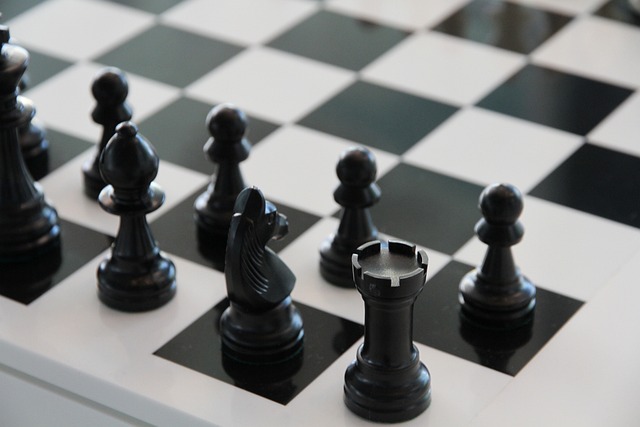Welcome to the world of chess, where every move counts and strategic thinking reigns supreme. Among the powerful pieces at your disposal, the rooks stand tall as the formidable towers of the chessboard. These majestic pieces possess immense potential, capable of wreaking havoc on your opponent’s position and dominating the board.
In this guide, we will delve into the art of using your rooks effectively, unveiling the secrets that will elevate your chess game to new heights. Whether you are a beginner seeking to understand the fundamentals or an experienced player looking to refine your skills, this exploration of rook mastery will provide you with invaluable insights and strategies.
Discover the tactical maneuvers that exploit the unique strengths of the rooks, enabling you to seize control and dictate the flow of the game. From the initial placement of your rooks to their coordinated attacks and defensive maneuvers, we will explore various scenarios and positional concepts that will sharpen your understanding of how to maximize the impact of these powerful pieces.
Throughout this journey, we will explore principles of rook mobility, open files, back-rank vulnerabilities, and the interplay between rooks and other pieces on the board. You will gain a deeper appreciation for the rooks’ ability to dominate the board and influence the outcome of a game.
So, whether you aspire to become a chess grandmaster or simply wish to improve your game, join us as we unravel the mysteries of effective rook usage. Get ready to enhance your strategic thinking, outmaneuver your opponents, and embark on a thrilling chess adventure where your rooks reign supreme.
Why are rooks important in chess strategy?
Rooks play a vital role in chess strategy due to their immense power and versatility. They are the heavy artillery of the chessboard, capable of exerting significant influence over the game. Rooks possess the ability to move vertically or horizontally across the board, covering long distances and controlling key files and ranks.
Their range of movement allows them to dominate open files, attack weak pawns, support other pieces, and participate in tactical combinations. Utilizing rooks effectively is crucial for successful strategic planning and achieving a favorable position on the board.
What are the basic moves of a rook?
The rook’s basic moves involve its unique ability to move horizontally or vertically, without any limit to the number of squares it can traverse. The rook can move forward and backward along ranks, as well as sidestep and move up or down along files.
This freedom of movement makes the rook a formidable piece that can navigate the chessboard with ease. Understanding the basic moves of a rook is fundamental to employing it effectively in your strategy and developing tactical plans.

How can I effectively control the center of the board with my rooks?
Controlling the center of the board is a key strategic objective in chess, and rooks can play a crucial role in achieving this dominance. By placing your rooks on central files, you establish a strong presence and gain control over important squares.
The rooks can support the advancement of your pawns, establish powerful attacks on the opponent’s position, and create threats that force your opponent to react defensively. Coordinating your rooks to exert control over the center can provide you with a solid foundation for launching attacks and maintaining strategic superiority.
Which are the most common rook maneuvers to consider?
There are several common rook maneuvers that chess players should consider to optimize the effectiveness of their rooks. One such maneuver is the rook lift, where a rook is moved to an open file, often the one adjacent to the king, to bolster its defensive capabilities or participate in an attack.
Another important maneuver is the rook swing, where a rook is moved from one side of the board to the other, contributing to a coordinated attack or reinforcing a defensive position. These maneuvers, along with others like the rook infiltration or the rook sacrifice, add depth to your strategic arsenal and enable you to exploit tactical opportunities.
How can I initiate a rook’s double attack?
A rook’s double attack is a potent tactical weapon that involves simultaneously attacking two different targets. To initiate a rook’s double attack, you need to identify vulnerable squares, pieces, or pawns that can be targeted by your rook’s influence.
By placing your rook on a file or rank that aligns with multiple targets, you can threaten both simultaneously. This puts your opponent in a difficult position, forcing them to make concessions or lose material. Mastering the art of the rook’s double attack can significantly enhance your tactical prowess and create opportunities for decisive victories.

What are the key principles for rook endgames?
Rook endgames are a common occurrence in chess, and understanding their key principles is essential for success. In rook endgames, activating your rook and centralizing it is crucial. Placing your rook on the seventh rank, known as the “seventh heaven,” allows it to exert pressure on your opponent’s pawns and potentially invade their position.
Another important principle is the idea of “rook behind the passed pawn,” where your rook supports the advancement of your passed pawn, creating threats and securing victory. Additionally, the ability to create “rook checks” and “rook forks” can be decisive in rook endgames. By grasping these key principles, you can navigate rook endgames with confidence and greatly increase your chances of success.
How do I coordinate my rooks with other pieces?
Coordinating your rooks with other pieces is a crucial aspect of chess strategy. One effective way to achieve this coordination is through piece placement and the establishment of harmonious relationships on the board. Consider positioning your rooks behind or beside powerful pieces such as the queen or the knight, enabling them to support each other’s movements and launch combined attacks.
Utilize your rooks to control key squares and lines of attack, while other pieces can complement their strengths and contribute to a cohesive strategy. By mastering the art of coordinating your rooks with other pieces, you can amplify their impact and unleash devastating combinations on your opponent.
How can I use my rooks to launch a successful attack?
Rooks possess immense firepower when it comes to launching attacks in chess. Their long-range capabilities allow them to penetrate deep into the opponent’s position, targeting weak pawns, exposed kings, or vulnerable squares.
To launch a successful attack with your rooks, focus on open files and semi-open files, as these provide ideal avenues for your rooks to infiltrate the opponent’s camp. Coordinate your rooks with other pieces, such as the queen or the bishop, to increase their attacking potential.
Look for tactical opportunities, such as discovered attacks or double attacks, to apply pressure and force concessions from your opponent. By effectively deploying your rooks in attack, you can create a menacing presence and pave the way for victory.
What are the defensive capabilities of rooks?
Rooks are not only offensive powerhouses but also formidable defensive assets. Their ability to control ranks and files makes them excellent guardians of the king and valuable in fortifying your position.
Placing rooks on the back rank or adjacent to the king can provide a solid shield against threats. Rooks excel in defending weak pawns or creating counterplay against aggressive enemy pieces. In addition, rooks can form defensive alliances with other pieces, utilizing their long-range capabilities to neutralize opposing attacks.
Understanding the defensive capabilities of rooks allows you to protect your position, repel enemy threats, and maintain a solid foundation for your strategic plans.

How do I exploit open files with my rooks?
Exploiting open files is a key strategy in chess, and rooks are the masters of utilizing these pathways. An open file refers to a column on the chessboard that has no pawns from either side.
Placing your rooks on open files allows them to dominate the board, control important squares, and exert pressure on the opponent’s position. By aligning your rooks on open files, you can launch powerful attacks, target weak pawns, or infiltrate deep into the opponent’s territory.
Remember to coordinate your other pieces, such as the queen or the bishop, to maximize the impact of your rooks on these open files. Mastering the art of exploiting open files with your rooks enhances your strategic vision and sets the stage for decisive maneuvers.
How can I use my rooks to support pawn promotion?
Pawn promotion is a critical phase in chess, and rooks can play a vital role in supporting this process. As pawns advance towards the eighth rank, where they can be promoted to a more powerful piece, rooks can provide essential support. Placing a rook behind an advancing pawn creates a strong defensive barrier and threatens to promote the pawn by force.
Rooks can also create threats against the opponent’s pieces or king, diverting their attention and enabling the pawn to advance uncontested. By effectively utilizing your rooks to support pawn promotion, you can gain a significant advantage and turn the tide of the game in your favor.
| Advantages | Considerations | |
|---|---|---|
| 1. Open Files | Provide opportunities for rook infiltration Enable powerful attacks on the opponent’s position |
Beware of counterplay Avoid overextension and vulnerabilities |
| 2. Rook Pairs | Enhanced coordination and control Support each other’s activities |
Require open lines and effective placement Avoid getting separated or trapped |
| 3. Rook Lift | Activate rooks from passive positions Surprise the opponent with unexpected threats |
Assess potential weaknesses Avoid exposing the king to attacks |
| 4. Seventh Rank | Offer opportunities for infiltration and checks Pressure the opponent’s pawns and pieces |
Watch out for counterplay and checks Be mindful of back-rank weaknesses |
| 5. Rook Sacrifice | Create tactical opportunities Clear paths for other pieces or pawns |
Calculate variations carefully Ensure sufficient compensation for the sacrificed rook |
What are the best strategies for rook vs. rook endgames?
Rook vs. rook endgames require careful maneuvering and strategic planning. In these scenarios, it is crucial to activate your rook and centralize it on open files or the seventh rank, where it can put pressure on the opponent’s pawns and restrict their king’s movement.
Utilize your rook’s mobility to create threats, checks, and forks that force your opponent into unfavorable positions. Additionally, understanding the importance of the “opposition” and the concept of “rook behind the passed pawn” can give you a significant advantage.
By combining these strategies with accurate calculation and precise moves, you can navigate rook vs. rook endgames with confidence and increase your chances of success.
How can I utilize the seventh rank with my rooks?
The seventh rank holds a special significance in chess, particularly when it comes to utilizing your rooks effectively. Placing your rooks on the seventh rank can exert tremendous pressure on your opponent’s position. From this vantage point, your rooks threaten to infiltrate deep into enemy territory, attack weak pawns, or disrupt the opponent’s coordination.
The seventh rank also allows your rooks to control important squares and restrict the opponent’s king’s mobility. By utilizing the seventh rank with your rooks, you can create a powerful presence on the board and set the stage for decisive attacks and strategic advantages.
Wrapping Up
In conclusion, mastering the effective usage of your rooks in chess is a crucial aspect of strategic play. Rooks possess immense power and versatility, capable of dominating the board, launching attacks, defending positions, and supporting pawn promotion.
By understanding the importance of rooks in chess strategy, learning their basic moves, and exploring various maneuvers, you can unlock their full potential and wield them as formidable weapons on the chessboard.
Coordinating your rooks with other pieces, exploiting open files, and utilizing the seventh rank are key strategies that amplify the impact of your rooks. Recognizing tactical motifs involving rooks enhances your ability to seize opportunities, win material, and outmaneuver your opponents. Furthermore, practicing rook maneuvering skills through study and practical play allows you to refine your understanding and execute precise moves.
Whether you are a beginner looking to improve your foundational skills or an experienced player aiming to refine your rook play, the journey toward utilizing your rooks effectively is one that combines knowledge, practice, and strategic thinking. By incorporating the insights and strategies discussed in this guide, you can elevate your chess game, command the board with your rooks, and pave the way for victories. So, embrace the power of your rooks, study their intricacies, and embark on a rewarding path toward mastery in chess.




